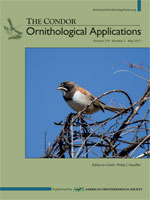Anthropogenic developments in marine coastal zones potentially overlap with areas of conservation interest, including important areas for birds. Ideally, spatial patterns of species abundance should be considered at ecologically relevant spatial resolutions (high resolutions) to inform spatial planning and environmental assessments. Most planning so far, however, has relied on coarse-resolution distribution maps from atlas projects or models often based on limited datasets (few surveys), and relationships with environmental variables have rarely been taken into account, leaving many studies and recommendations vulnerable to criticism. We therefore combined the strengths of a detailed database of spatially explicit aerial and ship surveys with high-resolution environmental predictors and species distribution models to predict detailed density patterns for 3 sea duck species, as part of an environmental impact assessment (EIA) in the southern Baltic Sea. We also compared the results from 2 different survey platforms to assess potential differences. We related survey data for Common Eiders (Somateria mollissima), Long-tailed Ducks (Clangula hyemalis), and Common Scoters (Melanitta nigra) to topographic variables, food resources, and anthropogenic pressures using 2-step generalized additive models accounting for zero inflation, nonnormality, and nonlinearity. We accurately predicted distribution patterns (the area under the receiver operating characteristic curve [AUC]: 0.79–0.84) and abundances (Spearman's correlation: 0.36–0.62) at a resolution of 750 m. However, abundance predictions based on aerial survey data differed in magnitude in comparison with predictions from ship survey data, particularly for the frequently diving Long-tailed Duck. We suggest that the main source of the differing abundance estimates was differences in the input data collected using different survey platforms, rather than the modeling approach. A correction factor for birds missed during surveys due to diving activity would therefore increase the accuracy of abundance estimates. Our results show that it is possible to fit ecologically interpretable relationships between species and environmental variables, allowing for the creation of high-resolution predictions useful for management and conservation.
How to translate text using browser tools
8 March 2017
High-resolution sea duck distribution modeling: Relating aerial and ship survey data to food resources, anthropogenic pressures, and topographic variables
Stefan Heinänen,
Ramūnas Žydelis,
Monika Dorsch,
Georg Nehls,
Henrik Skov
ACCESS THE FULL ARTICLE

The Condor
Vol. 119 • No. 2
May 2017
Vol. 119 • No. 2
May 2017
aerial surveys
Common Eider
Common Scoter
GAM
habitat modeling
long-tailed duck
ship surveys




